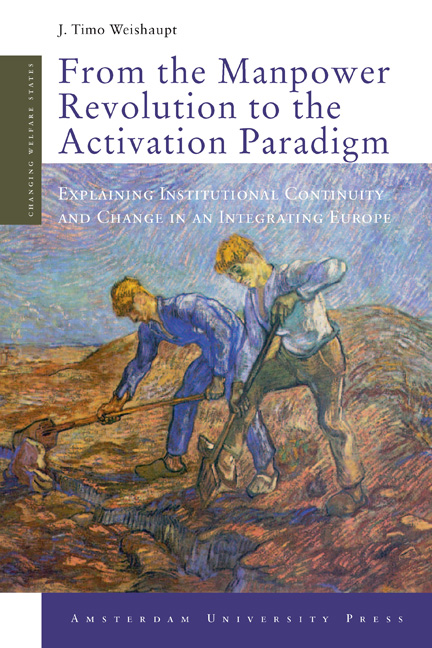 From the Manpower Revolution to the Activation Paradigm
From the Manpower Revolution to the Activation Paradigm Book contents
- Frontmatter
- Contents
- List of Boxes, Figures and Tables
- Abbreviations
- Acknowledgements
- I Introduction
- II Theoretical Approach
- Part I Origin and Crisis of European Labour Market Policy Regimes
- Part II The Emergence of the Activation Paradigm
- List of Interviews and Personal Conversations
- Notes
- Bibliography
- Index
- Changing Welfare States
VI - The Emergence of the Activation Paradigm: Analyzing Institutional Hybridisation
Published online by Cambridge University Press: 20 January 2021
- Frontmatter
- Contents
- List of Boxes, Figures and Tables
- Abbreviations
- Acknowledgements
- I Introduction
- II Theoretical Approach
- Part I Origin and Crisis of European Labour Market Policy Regimes
- Part II The Emergence of the Activation Paradigm
- List of Interviews and Personal Conversations
- Notes
- Bibliography
- Index
- Changing Welfare States
Summary
The previous three empirical chapters have illustrated three phases of cognitive and normative shifts, leading to new policy agendas and institutional changes. The first, institutional consolidation phase, lasting from the mid-1960s to the early 1970s, was characterised by an ideational convergence on the conceptual and normative merits of the Swedish concept of active labour market policies, which were seen as an adequate instrument to simultaneously improve the adaptability of national economies and the mobility of individual workers. These ideas were spearheaded by the OECD, especially Director of Manpower and Social Affairs Gösta Rehn, and resulted in a “manpower revolution”, associated with substantive national legislative changes, introducing or strengthening national public employment services and active manpower measures. The second “crisis” phase, lasting from the mid-1970s to the mid-1980s, was characterised by a major reorientation by national governments and the OECD alike. Keynesianism and other attempts to manage demand were gradually phased out and, in parallel, monetarist theory emerged, focusing on supply-side economics and inflation. With respect to labour market policy, there was no longer a clear point of reference for emulation and the OECD issued a variety of “theories” about the causes of, and remedies for, unemployment. This lack of a focal point reflected the dissent within the OECD about the most appropriate way to move forward as well as the existence of competing ideas about the role of labour market policies and institutions. It was during the 1980s that country trajectories increasingly showed divergence along three reform strategies: Anglophone marketisation, Continental labour shedding, and Nordic social investment. Chapter V, in turn, outlined the emergence of an “activation paradigm” with a uniquely Anglo-Nordic focal point.
The remainder of this book seeks to delve deeper into two sets of questions: First, this chapter asks what caused certain countries to become trendsetters in activation policy, and to what extent these changes have led to a convergence of national models. For this purpose, an analytical overview of recent developments is presented, which includes an assessment of the four dimensions of labour market policy regimes as outlined in chapter II. The primary focus is placed on the same six cases analysed in chapters III and IV.
- Type
- Chapter
- Information
- From the Manpower Revolution to the Activation ParadigmExplaining Institutional Continuity and Change in an Integrating Europe, pp. 193 - 252Publisher: Amsterdam University PressPrint publication year: 2012


